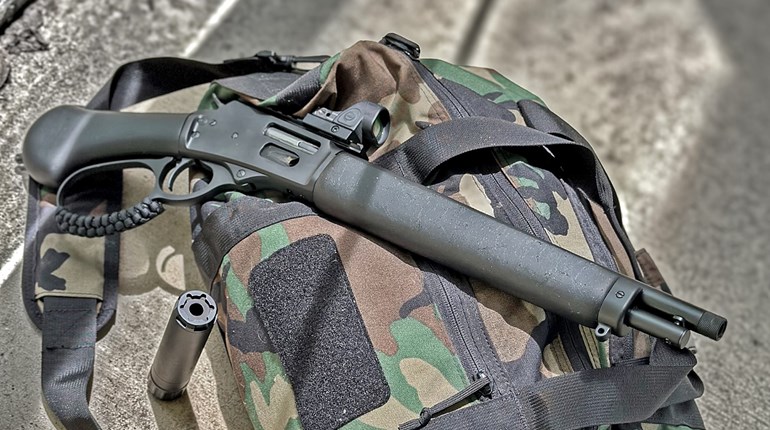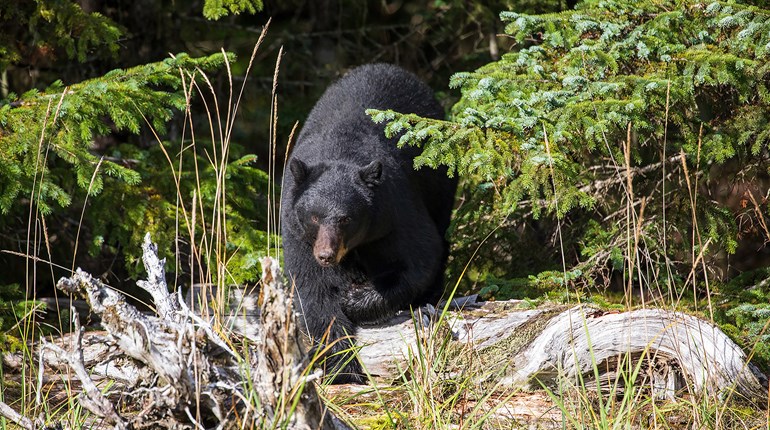
I know some of the more experienced handgun hunters will feel perhaps a bit slighted by the following discussion; we are repeating what you may already know, after all. However, that shouldn’t be the case. Getting back to basics can benefit even the veteran handgun hunter.
My goal is to introduce the uninitiated, drill the experienced and reflect on my own handgun hunting regimen. So I will focus on the mechanics and not the field craft of handgun hunting (that is a topic for another article). And I will focus on revolvers, not single-shot specialty pistols.
Choose a Platform
Finding a platform that suits you well is critical. Comfort goes a long way to building confidence. Will it be a single-action or double-action revolver? What caliber will fulfill your needs: .357 Mag., .44 Mag., .454 Casull? Long barrel? Short barrel? Scope? Open sights? There are a number of questions you need to answer honestly to help you home in on what will best serve you, the budding handgun hunter. If at all possible, you should try a number of different revolvers. Why? Because recoil characteristics vary greatly between the different types and makes of revolvers. Besides, the fact is large-caliber revolvers deliver sizable recoil.
Double-action revolvers tend to concentrate recoil force straight back into the web of your hand, while single-actions tend to twist upward, sparing the shooter some unpleasantness. The two configurations are worlds apart in how they transfer recoil to the shooter.
I could go into the various single-action grip-frame profiles, but we don’t have room for that here. My personal favorite is Ruger’s take on the Bisley grip frame as it is optimal for control—at least in my hands as it has a more double action-like recoil dynamism. Freedom Arms’ Model 83 grip is another one I really like. I would again recommend testing out a few of the different makes, models and calibers to help you make this decision. It is one that shouldn’t be taken lightly. If you don’t know anyone with a variety of revolvers to try, I suggest joining any number of websites dedicated to revolvers and handgun hunting. You may find folks locally through the site who can help you decide what is best by letting you shoot some of their revolvers.
Everyone has different preferences, so there are no hard and fast rules when it comes to picking a platform to fulfill your own needs. For me at least, single-action revolvers point more intuitively than do double-actions. Single-actions are almost an extension of the hand. Gunslingers of the Old West were undoubtedly well aware of this handling characteristic, relying on point-shooting for survival. Alas, we are not gunslingers, but handgun hunters. The single-action (in my hands at least) may offer some advantages when quick follow-up shots are needed to dispatch a departing animal.
This is as good a time as any to briefly discuss calibers. While the .357 Mag. is not my first choice, it can be effective. Remember that there is no replacement for placement, and a half-inch hole won’t make up for lousy marksmanship. Loaded with a quality bullet, I wouldn’t hesitate to use the first magnum on deer. However, I still prefer erring on the larger side with regards to calibers. The .41 Mag. is a good starting point and compromise, though factory ammunition is typically rather scarce. The champion of all big revolver rounds from an ammunition availability standpoint is the ubiquitous .44 Mag.. No revolver round can boast the sheer variety and quantity of available ammunition, and it is fully up to the task of taking nearly any head of game that has ever walked the face of this earth.
One of my personal favorites is the .45 Colt—yeah, that old blackpowder cartridge from the late 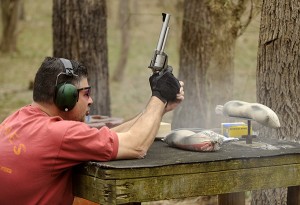 1800s. It can be loaded considerably hotter than its original configuration, which is limited to 14,000 psi. I am not suggesting turning your .45 Colt into a .454 Casull, but revolvers like Ruger’s Blackhawk in .45 Colt are considerably stronger than a Colt Single Action Army or any of the many facsimiles available on the market, and they are able to safely handle considerably hotter loads than the 14,000 psi maximum imposed upon the smaller and more fragile revolvers. Adhere to published load data and do not exceed the maximums recommended by the manufacturer as there is no need to turn your favorite revolver into a hand grenade.
1800s. It can be loaded considerably hotter than its original configuration, which is limited to 14,000 psi. I am not suggesting turning your .45 Colt into a .454 Casull, but revolvers like Ruger’s Blackhawk in .45 Colt are considerably stronger than a Colt Single Action Army or any of the many facsimiles available on the market, and they are able to safely handle considerably hotter loads than the 14,000 psi maximum imposed upon the smaller and more fragile revolvers. Adhere to published load data and do not exceed the maximums recommended by the manufacturer as there is no need to turn your favorite revolver into a hand grenade.
There are quite a few big calibers that are fairly brutal to shoot; I don’t recommend them to the neophyte. There are some, like the .480 Ruger, which offer a fine compromise between power and recoil. However, the fact is you can load the big calibers down to “soft” levels and they still offer a sizable advantage over their smaller siblings. They don’t need to be pushed hard to be terminally effective. Keep this in mind when you decide upon a caliber for a hunting revolver.
You need to be honest with yourself as far as your limitations are concerned. There is no shame in a low tolerance for recoil. These big-bore revolvers can be very difficult to shoot as you generally have only 3 pounds in your hands to contain the considerable recoil generated by some of these cartridges. The prospective handgun hunter should take pride in being able to shoot his/her chosen revolver well and effectively. Let someone else’s ego dictate his caliber choices. Competence and confidence will go a long way to filling the freezer with game meat. Confidence follows competence, and consistent competence is the offspring of practice—lots of practice—but more on this later.
Let’s talk bullets briefly. We live in what I consider the Golden Age of handgun bullets. We have bonded, jacketed, controlled expansion, violently expanding, deep-penetrating, soft-point, flat-point, hollow-point, monometal and hardcast bullets and more. I think it is important to match your bullet to your game. Soft, thin-skinned game responds well to violently expanding bullets where deep penetration isn’t needed. When hunting thick-skinned, heavy-boned animals, an expanding bullet of tougher construction (like Hornady’s Magnum XTP or the Swift A-frame), or a minimally expanding bullet like a flat-nosed hardcast, is preferable. Expansion is more critical in smaller calibers, but when your bullet is starting out at or nearly a half-inch in diameter, expansion isn’t all that critical. All that said, I always prefer two holes to one, and put a premium on penetration. I am taking a harder look at some of the monometal designs that have cropped up recently like those offered by Cutting Edge Bullets (CEB). Their Raptor bullets are designed to open up and then shed their petals while the core base continues to plow forward like a solid, offering the best of both worlds: deep penetration as well as a large wound channel.
Learn to Shoot
Now that you have chosen your revolver, it is time to learn how to shoot it well. In no uncertain 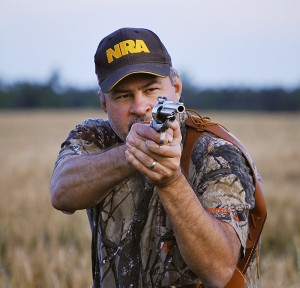 terms, shooting a handgun accurately is more difficult than a rifle. Handgun shooters/hunters don’t have the luxury of using their bodies to stabilize their firearms by bracing the buttstock firmly in their shoulders.
terms, shooting a handgun accurately is more difficult than a rifle. Handgun shooters/hunters don’t have the luxury of using their bodies to stabilize their firearms by bracing the buttstock firmly in their shoulders.
Consistency is the name of the game here—consistency of grip pressure and consistency of trigger control. Changing your grip tension will change the point of impact of your bullets. This is why it is so important to shoot in the same manner each and every time. Repetition is habit-forming. If, when practicing, fatigue begins to rear its head, it is time to either rest or stop for the day. Bad habits can form quickly when pushing your own limits, and if your grip begins weakening during a shooting session, your marksmanship will suffer. Limit your time on the range until you are in “shooting shape.” You should end each range session on a high note. This will allow your muscles to retain the memory of doing things correctly. It serves no one to shoot until he develops a flinch. Undoing a flinch can be frustrating and time-consuming. You will know when you reach your limit. When you do, it is time to pack up for the next practice session.
Range time should be spent on the various field positions, while the bench should be visited sparingly only to sight-in and to check zero. Field positions should include offhand practice, which I find to be very useful. In fact, I spend most of my practice time shooting offhand. The two reigning offhand shooting stances are the isosceles and the Weaver stance. The isosceles puts both of the shooter’s feet on line (actually the latest trend is to drop the strong-side foot back a bit but not as severely as with the Weaver stance). The shooter faces nearly flat towards the target with both arms parallel to each other straight out or slightly bent. Equal pressure is applied to the gun 360 degrees. This is great for defensive shooting, not so good with a heavy revolver that generates a lot of recoil. The user of the Weaver stance pulls the revolver with the weak hand, and pushes with the strong hand. I use a modified Weaver stance, with my weak-side forward, my supporting arm’s elbow tucked to my side for support. The Weaver (at least for me) is more logical and comfortable. I boxed for a couple of decades so a fighting stance (leading with the weak side) is a natural for me.
Shooting sticks should also be part of your practice regimen. I have a set from Stoney Point (tripod) I am quite fond of. I use them at the range, and out in the field. Sticks aren’t burdensome to carry, and they offer the hunter a good, solid rest—and they are quickly and easily deployed with practice. A rest should always be considered where available, as it can increase your success rate exponentially.
You can practice without breaking your bank or your wrists. Sessions don’t have to be long on time and ammunition. Focus on your first shot as this is always the most critical when hunting. You don’t need to be able to put strings of shots together in one hole at 100 yards. But you should be able to put one bullet in your intended target the first try.
What I am going to talk about now should be considered serious and useful advice. Practice should not be limited to the range, particularly if you are like most of us in that you have a life that is chaotic, short on time and long on work, and not conducive to frequent trips to the range. Burning powder is good, but dry-firing is also a great exercise to get you in shape for the hunt. Keep in mind that some revolvers will require snap caps to perform this practice regimen (contact the manufacturer for recommendations). Trigger squeeze/control is the name of the game here. A jerked trigger will throw shots way off target. Muscle memory requires time on the trigger, and there is no way around this if you want to be a successful handgun hunter. I get in front of the television (much to the chagrin of my wife), and I practice my trigger squeeze by dry-firing. Even the dogs look at me like I am crazy (they are very intuitive). Perform so many repetitions that your shots—all of them—become mechanical and devoid of emotion. This will help you when you have the buck of a lifetime in your sights.
One more thing: Small-caliber revolvers are good for practice as well. No need to assault your senses and abuse your body all the time. Low recoil will allow you to perform and analyze your fundamentals, and practice that critical trigger squeeze.
Sighting Options
Your eyes (and age, subsequently) will play a large role in helping you choose a sighting system for your revolver. I am not a big fan of scopes on revolvers. The eye relief is just too great for me and the wobble all shooters exhibit is greatly exaggerated when peering through a scope with some magnification. I understand the appeal—a good rest and a variable-power scope make those long shots doable. But that’s not why I got into handgun hunting. I like to get close. It’s just a personal preference. I really like red dot sights, as they are very hard to beat in low light. The downside is that they rely on batteries to function and could leave you high and dry in the field. I carry spares just in case, but I am happy to report that I have never experienced such a failure on a hunt.
For the purist, open iron sights are the only way to fly. Some of my revolvers will never, ever be fitted with an optic. This is purely aesthetic for me, but I also love the fact an iron-sighted revolver can sit in a holster and not be intrusive in any way yet can be pressed into action quickly as a result.
Now I would like you to go back and reexamine your regimen. Remember that practice is absolutely critical and that practice can be performed in the comfort of your home. Trigger control is of absolute importance to making first shots on game. What are you waiting for? Practice, you will be better for it and reap the rewards of knowing that you successfully chose the harder path to hunting prosperity.
Have It Your Way: The Custom Option
What if you just can’t find what you are looking for in a commercial hunting revolver? This is a 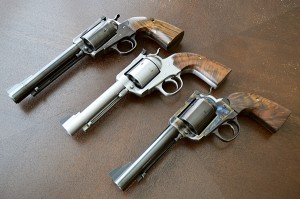 subject near and dear to my heart: I am rather obsessed with custom revolvers, single-actions in particular. Nothing quite offers a blank canvas to the custom revolver builder like the venerable Ruger Blackhawk. It is hands-down the preferred foundation by custom gun builders like John Linebaugh, Hamilton Bowen, Jack Huntington, Alan Harton, John Gallagher … the list goes on. There are a number of very fine gun builders who can turn the ordinary into the wheelgun of your dreams. All it takes is an imagination, and pockets deep enough to bring it to fruition.
subject near and dear to my heart: I am rather obsessed with custom revolvers, single-actions in particular. Nothing quite offers a blank canvas to the custom revolver builder like the venerable Ruger Blackhawk. It is hands-down the preferred foundation by custom gun builders like John Linebaugh, Hamilton Bowen, Jack Huntington, Alan Harton, John Gallagher … the list goes on. There are a number of very fine gun builders who can turn the ordinary into the wheelgun of your dreams. All it takes is an imagination, and pockets deep enough to bring it to fruition.
Let’s look at the foundation first. The Ruger Blackhawk, in all of its iterations over the years of its production, is a strong and aesthetically pleasing starting point. It lends itself well to large-caliber conversions and other custom creativity, and it can be tuned and polished to perfection.
Any of the above mentioned gunsmiths will build you a first-rate custom revolver to your liking. The three on display here are mine and were built by Jack Huntington of JRH Advanced Gunsmithing (530-268-6877). They are a reflection of my own needs, desires and tastes in a custom revolver. From the top is a .500 Maximum, built on the limited-edition .357 Maximum Blackhawk of the early 1980s. This is not a caliber for the faint of heart. It’s quite difficult to master as it slings 525-grain bullets at 1350 fps, making it quite the handful in a 3 1/2-pound package.
The stainless Bisley in the middle started life as a Williams Shooting Supply distributor exclusive .45 Colt Bisley, and has been fitted with a re-chambered Ruger .44 Mag. cylinder (tight chamber specifications). This is one of my favorite go-to revolvers, as it packs easily, shoots accurately and delivers a sizable punch.
Lastly, my newest acquisition: a Ruger Bisley in .500 JRH, replete with a 5 1/2-inch PacNor barrel, five-shot cylinder, custom walnut grips and color-casehardening by Doug Turnbull.
Each of these revolvers will return great accuracy as long as I am doing my part. The Maximum is easy to get out of sorts with if you don’t shoot it regularly. Its recoil is rather heavy; if I don’t pick it up and shoot it frequently, I have to teach myself how over and over again. There is nothing commercially available that is comparable to a revolver built to your specifications.
454 Reasons to Rejoice
Some guns just flat-out shoot. This Ruger Super Redhawk (SRH) in the rambunctious .454 Casull has exhibited exceptional accuracy from day one. Newly configured with a barrel profile featuring no taper and a new front sight, the .454 SRH is otherwise unchanged. Upon delivery I fitted the big revolver with an Ultradot 30 red dot sight with Ruger’s own 30mm rings. I shot my first targets at 25 yards to get it on paper, and after some adjusting pushed it out to 50 yards. Loaded with Federal’s fantastic 300-grain Swift A-Frame loads, running an advertised 1,520 fps, I have managed to shoot a number of sub-1 inch five-shot groups off the bench. The best measured a meager three-quarters of an inch. Wow! I typically limit my hunting-revolver testing to 50 yards as that gives a good indicator how the gun will perform up close and at distance. This revolver deserved further testing, so I stretched its legs out to 100 yards. It didn’t disappoint, delivering a number of 1 3/4-inch five-shot groups. Can’t argue with that! The Ruger SRH/Federal Swift A-frame load combination is a match made in heaven.
The Prodigal Gun
The big news for 2014 is the return of the .480 Ruger Super Redhawk (SRH). Plagued with 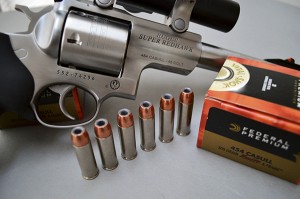 purported sticky extraction since its inception in 2001, the on-again off-again .480 Ruger SRH is back for good now, or so we have been assured.
purported sticky extraction since its inception in 2001, the on-again off-again .480 Ruger SRH is back for good now, or so we have been assured.
The very first cartridge to bear the Ruger name, the .480 was met with lukewarm enthusiasm as it couldn’t compete for the most powerful or fastest titles at its inception, standing in the shadow of Smith & Wesson’s behemoth .500 Mag. However, those with the ability to see past paper ballistics didn’t dismiss this new offering and instead saw it for the potential it promised: one of the best handgun hunting rounds to grace the market. The .480 Ruger boasts big diameter (.476 inch), relatively mild recoil and great terminal effectiveness on big game. Like my recently acquired .454 Casull SRH, the re-released .480 Ruger Super Redhawk is no slouch either. Back now with a 7 1/2-inch bull barrel (like the .454 version), a revised front sight and new chamber dimensions (remember the complaint about the .480 SRH has always been sticky extraction), I was eager to take the new and improved .480 SRH for a spin.
The Prodigal Gun didn’t disappoint. Shooting Buffalo Bore factory loads of 370 grains (a wide, flat-nosed hardcast bullet), I was able to put four shots (operator error: I pulled the fifth) into an outstanding quarter-inch group. Holy smoke! I have tried some handloaded 220- and 280-grain Raptors (monometal hollow-points designed to shed their petals in game) from Cutting Edge Bullets (CEB) that routinely delivered sub-1-inch five-shot groups at 50 yards. This is very promising. By the time you read this, the .480 Ruger SRH should be available in this new configuration.












